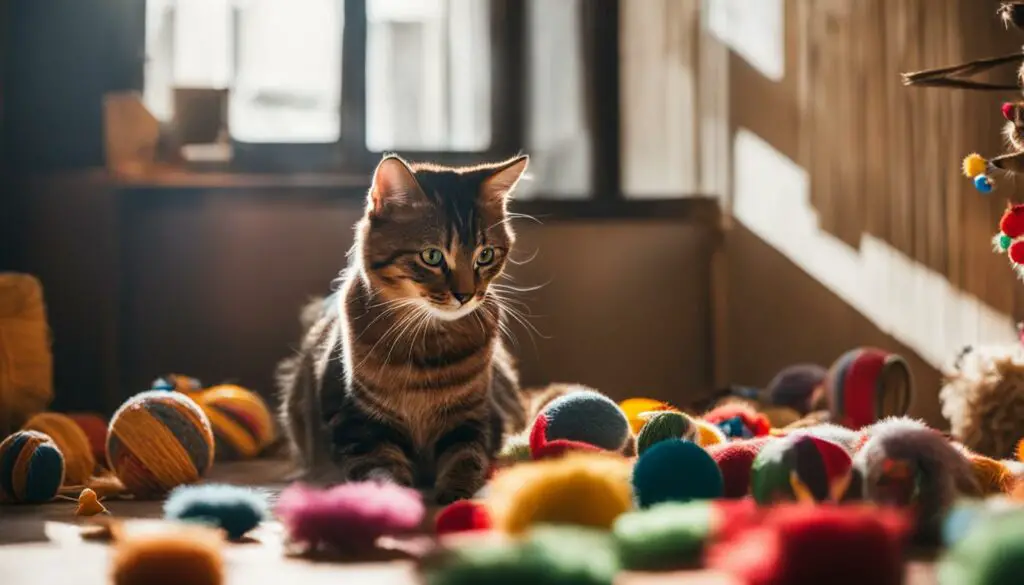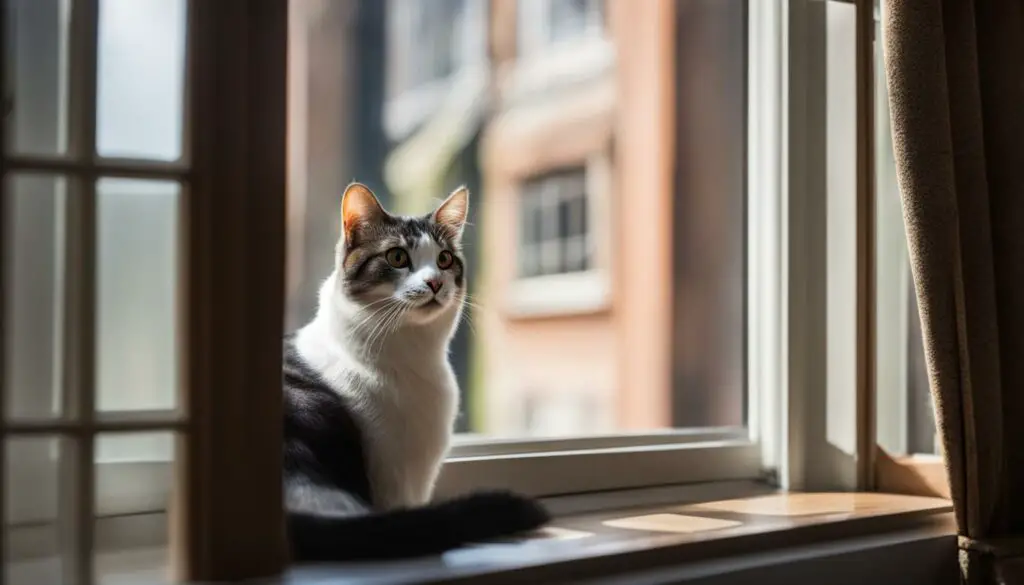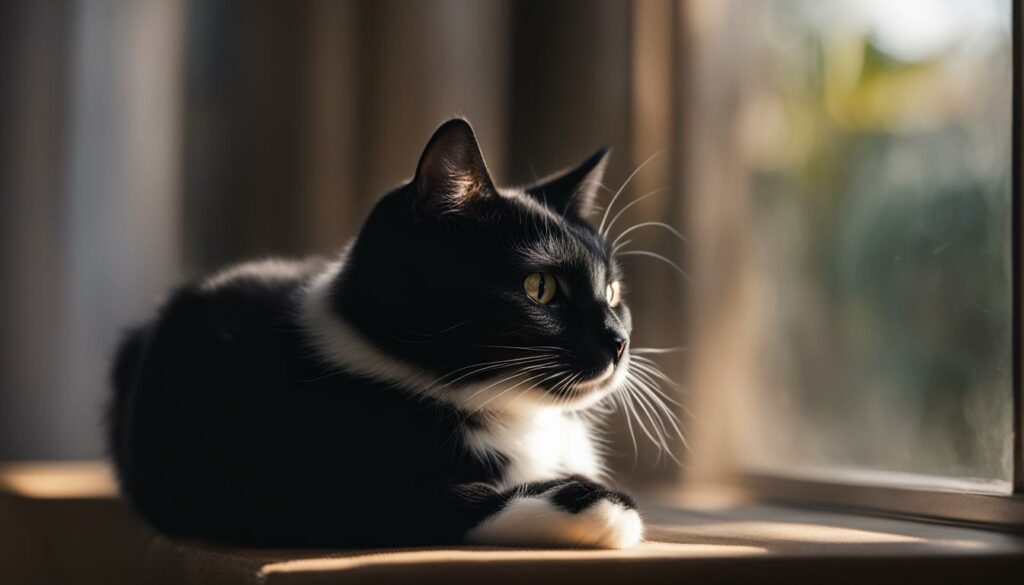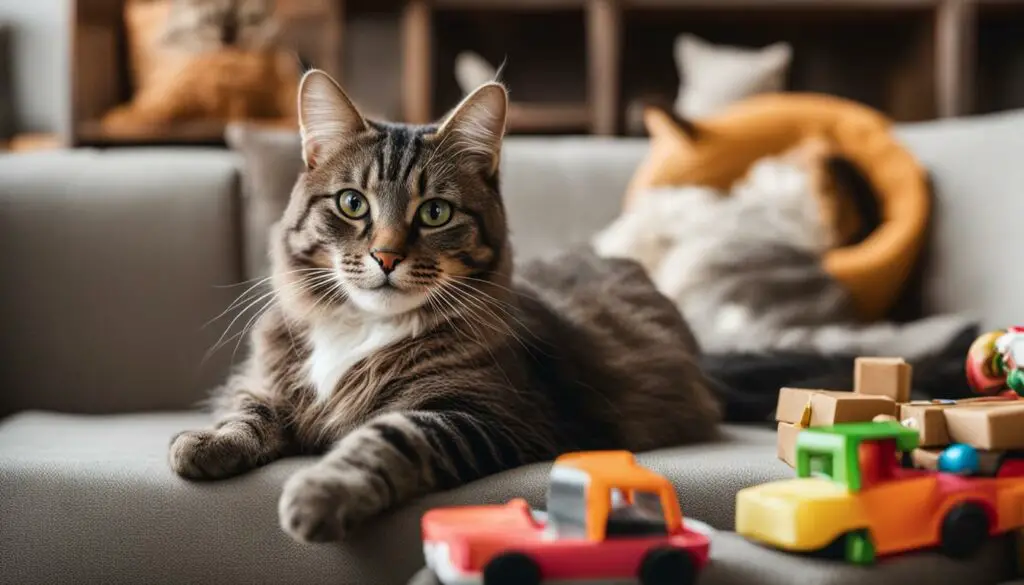Leaving cats alone for 3 days is a common concern for cat owners. While it is generally not recommended to leave cats alone for extended periods, there are certain considerations to keep in mind to ensure your cat’s well-being. This article will provide insightful perspectives on how to take care of your cat when you’re away for 3 days.
Key Takeaways:
- Leaving cats alone for 3 days requires careful planning and consideration of their needs.
- Understanding feline independence and loneliness is important for providing proper care.
- Providing essential resources such as food, water, and a clean litter box is crucial.
- Ensuring safety and security by cat-proofing your home and having a plan for emergencies.
- Creating an enriched environment with toys and activities helps keep your cat mentally stimulated.
Understanding Feline Independence and Loneliness
Cats are known for their independent nature, but it is essential to understand that they still require companionship and social interaction for their overall well-being. When left alone for extended periods, cats can experience feelings of loneliness and may even develop separation anxiety. As responsible pet owners, it is crucial to be aware of their needs and take appropriate measures to address them.
Feline loneliness can manifest in various ways, including changes in behavior, excessive meowing, or destructive behavior. Cats are social animals, and they rely on interactions with their human companions or other animals to feel secure and fulfilled. Lack of companionship can have a detrimental impact on their mental and emotional health.
Understanding cat behavior and communication is key to ensuring their well-being when you’re away. By observing their body language, vocalizations, and overall demeanor, you can gauge their level of comfort and happiness. Providing them with opportunities for pet companionship, such as play sessions and interactive toys, can help alleviate loneliness and prevent separation anxiety.
| Common Signs of Feline Loneliness and Separation Anxiety | Ways to Address Feline Loneliness and Separation Anxiety |
|---|---|
|
|
Remember, cats may show different responses to loneliness and require individualized care. Always consult with a veterinarian or a professional animal behaviorist for guidance on addressing feline loneliness and separation anxiety.

Providing Essential Resources for Your Cat
When leaving your cat alone for 3 days, it’s crucial to ensure they have access to essential resources. These include cat food, water, a clean litter box, toys, a scratching post, a comfortable bed, and a secure carrier. Let’s explore each of these elements in detail:
Table: Essential Resources for Your Cat
| Resource | Importance |
|---|---|
| Cat Food | Provide enough food for your cat’s daily nutritional needs. Consider automatic feeders or portion control devices to ensure they receive the right amount at the right time. |
| Cat Water | Ensure a constant supply of fresh water to keep your cat hydrated. Consider using a water fountain to encourage drinking. |
| Litter Box | Maintain a clean litter box by scooping it daily. If you’re leaving for 3 days, consider having an extra litter box available. |
| Cat Toys | Provide a variety of toys to keep your cat mentally stimulated. Interactive toys, puzzle feeders, and toys that mimic prey can help alleviate boredom. |
| Cat Scratching Post | Offer a suitable scratching post to fulfill your cat’s natural need to scratch and stretch. This will help keep their claws healthy and prevent furniture damage. |
| Cat Bed | Provide a cozy and comfortable bed where your cat can rest and feel safe. Choose a bed that suits your cat’s size and preferences. |
| Cat Carrier | Have a secure and well-ventilated carrier ready in case of emergencies or when transporting your cat. Ensure it’s large enough for your cat to move comfortably. |
In addition to the essential resources mentioned above, it’s vital to ensure your cat is up to date on vaccinations and has received necessary veterinary care before you leave. This will help maintain their overall health and prevent any potential issues during your absence. Consult with your veterinarian to schedule a check-up and discuss any specific concerns or recommendations.
Remember, providing these essential resources will help your cat feel comfortable, entertained, and well-cared for while you’re away. By addressing their basic needs, you can ensure their well-being and peace of mind.

Ensuring Safety and Security for Your Cat
When leaving your cat alone for 3 days, it’s important to prioritize their safety and security. Here are some key measures you can take to ensure their well-being:
1. Cat-Proofing Your Home
Before you leave, thoroughly cat-proof your home to remove any potential hazards or toxic substances. Secure dangerous items such as chemicals, household cleaners, and medications in cabinets or lock them away in a designated area. Ensure that all cords, cables, and household appliances are safely stored or covered to prevent any accidents or injuries. Pay special attention to small objects that could be swallowed or cause choking hazards. By taking these precautions, you can create a safer environment for your cat during your absence.
2. Establishing an Emergency Plan
In case of any unforeseen emergencies, it’s crucial to have an emergency plan in place. Keep a list of emergency contact numbers for your veterinarian or a nearby emergency veterinary clinic easily accessible. Familiarize yourself with the signs of common pet emergencies so that you can take appropriate action if needed. Additionally, make sure that friends or family members are aware of your absence and have access to your home in case they need to check on your cat or provide assistance.
3. Providing a Safe and Secure Cat Carrier
A reliable and secure cat carrier is essential for both travel and emergencies. Make sure your cat has a comfortable and properly ventilated carrier that is suitable for their size. Introduce the carrier to your cat gradually and associate it with positive experiences such as treats or short trips to reduce any potential anxiety. Having a familiar and secure carrier will come in handy in situations such as evacuation or transportation to the veterinarian.

| Cat Safety Tips | Security Measures |
|---|---|
| Keep household cleaners and toxic substances out of reach | Secure your home and remove potential hazards |
| Store medications in a safe place | Establish an emergency plan and have contact numbers readily available |
| Secure cords, cables, and household appliances | Provide a safe and secure cat carrier for travel and emergencies |
By taking these precautions and implementing safety measures, you can ensure that your cat is protected and secure while you’re away. Remember, your cat’s well-being is of utmost importance, and proper planning and preparation are essential for their safety and security.
Creating an Enriched Environment for Your Cat
When leaving your cat alone for 3 days, it’s important to create an enriched environment that keeps them mentally and physically stimulated. Cats are natural hunters and need outlets for their instincts, so providing toys that simulate prey, such as interactive puzzle toys or feather wands, can keep them engaged. Additionally, having scratching posts and climbing areas allows them to exercise and stretch their muscles.
Grooming is an important aspect of cat care, and it also provides an opportunity for bonding. Regular brushing helps keep your cat’s coat healthy and reduces shedding, while also providing a calming effect. Cats also enjoy having their territory marked, so providing designated areas for scratching and marking can help them feel more secure.
“Cats are natural hunters and need outlets for their instincts, so providing toys that simulate prey, such as interactive puzzle toys or feather wands, can keep them engaged.”
Another way to enrich your cat’s environment is by creating different play areas throughout your home. This gives them the opportunity to explore and provides mental stimulation. You can designate certain areas for playtime by placing toys, climbing structures, and scratching posts in those areas. This helps create a sense of territory and gives your cat options for activities.
| Enrichment Ideas | Description |
|---|---|
| Food puzzles | Hide small amounts of food in puzzle toys to encourage your cat’s natural hunting instincts. |
| Window perches | Place a perch near a window so your cat can enjoy watching birds or other outdoor activity. |
| Hide and seek games | Hide treats or toys around the house for your cat to find, encouraging exercise and mental stimulation. |
| Rotating toys | Switch out your cat’s toys regularly to keep them interested and prevent boredom. |
Ultimately, creating an enriched environment for your cat helps to prevent boredom and reduces stress and anxiety. By providing the necessary physical and mental stimulation, you can ensure that your cat remains happy and healthy while you’re away for 3 days.

Establishing a Communication Routine
When leaving your cat alone for 3 days, it’s important to establish a communication routine to ensure their well-being and provide reassurance. Cats communicate through various vocalizations and body language, and understanding their cues can help you gauge their feelings and address any potential issues.
Understanding Cat Vocalizations
Cats use vocalizations such as meowing, purring, and hissing to communicate their needs and emotions. Each vocalization has its own meaning, and paying attention to your cat’s sounds can help you understand their state of mind. For example, meowing can indicate hunger or a desire for attention, while purring often signifies contentment and relaxation. On the other hand, hissing can be a sign of fear, aggression, or discomfort.
Observing Body Language
In addition to vocalizations, cats communicate through their body language. Pay attention to your cat’s posture and gestures to better understand their emotions. For example, a relaxed and open body posture indicates contentment, while a hunched or tense body posture may suggest fear or anxiety. Understanding your cat’s body language can help you respond appropriately and provide the comfort they need.
“Cats use vocalizations such as meowing, purring, and hissing to communicate their needs and emotions.”
Consistency and Reassurance
Establishing a communication routine before you leave can provide reassurance to your cat and help alleviate any anxiety they may experience. Spend time talking to your cat, using their name, and offering gentle petting or playtime. Consistency in your tone of voice and actions will help your cat associate the communication routine with positive experiences, making them feel more secure in your absence.
By establishing a communication routine and understanding your cat’s vocalizations and body language, you can help ensure their well-being when you’re away. Remember to be patient and attentive to their needs, providing the necessary reassurance and comfort to help them feel safe and secure.

Setting Up a Feeding Schedule
When leaving your cat alone for 3 days, it’s crucial to establish a proper feeding schedule to ensure their well-being. Cats thrive on routine, and a consistent feeding schedule helps maintain their health and prevents digestive issues. Here are some essential tips for setting up a feeding schedule for your feline friend:
Determine the Number of Meals
In general, cats should be fed two to three times a day. Divide their daily recommended portion into equal meals to provide them with regular nourishment throughout the day. This ensures that your cat receives a balanced diet and avoids overeating.
Measure the Portion Sizes
To prevent overfeeding or underfeeding, it’s essential to measure your cat’s food portions accurately. Follow the feeding guidelines provided by your cat’s veterinarian or the instructions on the cat food packaging. Adjust the portion sizes based on your cat’s age, weight, activity level, and any specific dietary needs they may have.
| Meal | Portion Size |
|---|---|
| Morning | 1/3 cup of dry cat food |
| Afternoon | 1/4 cup of wet cat food |
| Evening | 1/3 cup of dry cat food |
Provide Fresh Water
Along with regular feeding, it’s crucial to ensure your cat has access to fresh water throughout the day. Consider using a cat water fountain to provide a continuous supply of clean water. Cats are more likely to drink water when it’s flowing, and a water fountain can encourage proper hydration.
Limit Treats
While treats can be a fun way to bond with your cat, it’s important to limit their intake, especially when you’re away. Excessive treats can lead to weight gain and digestive issues. Stick to a few healthy treats or incorporate them into their regular meals.

By following these tips and setting up a feeding schedule for your cat, you can ensure that they receive the right amount of food and water while you’re away. Remember to consult with your veterinarian for specific feeding recommendations based on your cat’s individual needs.
Seeking Professional Help – Pet Sitting and Boarding
When you are facing the dilemma of leaving your beloved cat alone for three days, seeking professional help through pet sitting or boarding can provide you with peace of mind. Professional pet sitters are experienced in cat care and can offer companionship, feeding, and ensure your cat’s overall well-being while you are away.

If you prefer a more structured environment, boarding facilities are a great option. These facilities provide a safe and secure space where your cat receives professional care, ensuring they are fed, given proper attention, and receive any necessary medications. Boarding facilities often have staff members who are trained to handle emergencies and can provide your cat with the attention they need while you are away.
Before choosing a pet sitter or boarding facility, make sure to do your research. Ask for recommendations from friends, family, or your veterinarian. Consider conducting interviews or visits to ensure the environment is clean, secure, and suitable for your cat’s needs. Checking reviews or testimonials can also help you make an informed decision and provide you with peace of mind while you are away.
Preparing Your Cat for Your Absence
Leaving a cat alone for 3 days can be a challenging experience, but with proper preparation and care, you can help minimize any stress or anxiety they may feel. By taking the time to train your cat and address any behavior problems beforehand, you can create a more positive environment for them while you’re away. Gradually increasing periods of separation leading up to your departure can also help acclimate your cat to being alone.
Cat training is an important aspect of preparing your feline friend for your absence. Teaching them basic commands, such as “sit” or “stay,” can help establish boundaries and provide mental stimulation. Positive reinforcement techniques, such as rewards or treats, can motivate your cat and make the training process more enjoyable.
“Training my cat before leaving for a few days really helped create a sense of structure and routine for both of us. It gave me peace of mind knowing that my cat was well-prepared and comfortable in my absence.”
Addressing any behavior problems before you leave is also crucial. If your cat has a tendency to scratch furniture or engage in other destructive behaviors, consider providing appropriate alternatives, such as scratching posts or interactive toys. Consult with a veterinarian or a professional cat behaviorist if needed, as they can provide additional guidance and support.
Reducing Cat Stress
Reducing stress is key to helping your cat feel more comfortable and relaxed during your absence. Creating a calm and soothing environment can make a significant difference. Play soft music or use pheromone diffusers, such as Feliway, to help create a sense of familiarity and comfort for your cat. Additionally, ensuring that their favorite toys, bedding, and hiding spots are easily accessible can provide a sense of security.
Remember, every cat is unique, so it’s important to consider their individual needs and preferences when preparing for your absence. By taking the time to train your cat, address any behavior problems, and create a stress-free environment, you can help ensure their well-being and peace of mind during your time away.
| Tips for Preparing Your Cat for Your Absence | |
|---|---|
| Cat Training | Teach your cat basic commands using positive reinforcement techniques. Gradually increase periods of separation to help them acclimate to being alone. |
| Address Behavior Problems | Provide appropriate alternatives for destructive behaviors. Consult with a professional if needed. |
| Reduce Stress | Create a calm environment with soft music and pheromone diffusers. Make sure their favorite toys and hiding spots are easily accessible. |
Ensuring Proper Health and Hygiene
When leaving your cat alone, it’s crucial to prioritize their health and hygiene. Before your departure, schedule a veterinary check-up to ensure your cat is in good health and address any underlying issues. Regular grooming is also essential to keep your cat clean and comfortable.
During the veterinary check-up, make sure your cat is up to date on vaccinations and preventative treatments. Discuss any specific concerns you may have with the veterinarian, such as allergies, skin conditions, or dietary requirements.
Grooming your cat regularly not only helps maintain their appearance but also promotes good overall health. Brush their fur to remove loose hair and prevent matting. This can reduce the risk of hairballs and skin irritation. Additionally, check their ears for any signs of infection, trim their nails to a safe length, and brush their teeth regularly to improve oral hygiene.

Table: Essential Cat Health and Hygiene Practices
| Practice | Frequency |
|---|---|
| Annual veterinary check-up | Once a year |
| Vaccinations | As per veterinarian’s recommendation |
| Regular brushing | A few times a week |
| Ear cleaning | Once a month |
| Nail trimming | Every 2-3 weeks |
| Teeth brushing | 2-3 times a week |
By prioritizing your cat’s health and hygiene, you can help them stay happy and comfortable while you’re away. Regular veterinary care and grooming practices will contribute to their overall well-being and reduce the risk of any health issues arising during your absence.
Providing Comfort and Security
When leaving your cat alone for 3 days, it’s essential to create a comfortable and secure environment to ensure their well-being. Cats rely on their surroundings for comfort and safety, so here are some tips to help them feel secure during your absence.
Creating a Cozy Retreat
Cats love having a dedicated space to call their own. Provide them with a comfortable cat bed where they can curl up and sleep peacefully. Consider placing the bed in a quiet corner or near a window for them to enjoy natural light and watch the world go by. Additionally, some cats prefer to hide when they feel insecure, so offering a hiding spot, such as a covered cat cave or a cozy blanket fort, can provide them with a sense of safety.
Engaging Playtime and Hunting Opportunities
Interactive play is crucial for keeping your cat stimulated and mentally engaged. Before you leave, spend quality time playing with your cat using interactive toys or engaging them in a game of chase. This helps fulfill their natural hunting instincts and provides an outlet for their energy. You can also leave some puzzle toys or treat-dispensing toys to keep them mentally engaged while you’re away.
Building Strong Bonds
Cats thrive on bonding with their owners. Before you leave, make sure to spend extra quality time with your cat, providing plenty of love, attention, and affection. Gently petting and grooming your cat will help them relax and strengthen your bond. Engaging in activities they enjoy, such as brushing their fur, can help them associate positive experiences with your presence and reassure them during your absence.
Creating a Relaxing Atmosphere
Cats are sensitive to their environment, so it’s important to create a calming atmosphere for them. Consider using Feliway diffusers, which release synthetic pheromones that mimic the natural calming scents of cats, helping to reduce stress and anxiety. You can also play soft classical music or soothing nature sounds to create a peaceful ambiance. Keeping a familiar blanket or clothing item with your scent nearby can also provide comfort and reassurance to your cat.

Addressing Specific Concerns and Challenges
When it comes to leaving your cat alone for 3 days, there may be specific concerns and challenges that you need to address. Each cat is unique, and understanding their individual needs is crucial in ensuring their well-being while you’re away. Let’s explore some common concerns and how to tackle them:
Socialization
Cats are known for being independent, but they still require socialization and interaction. If your cat is used to having company, leaving them alone for 3 days can be challenging. To address this, consider having a trusted friend or family member check in on your cat, engage in playtime, and provide companionship. Alternatively, you can explore cat daycare or boarding options that offer socialization opportunities with other cats.
Climbing and Exercise
Cats love to climb, explore, and exercise. When left alone for 3 days, it’s important to ensure they have access to vertical spaces and engaging activities. Provide cat trees or shelves where they can climb and observe their surroundings. Interactive toys and puzzle feeders can also help keep them mentally and physically stimulated while you’re away.
Communication
Cats communicate through a variety of vocalizations and body language. It’s essential to understand your cat’s communication cues to gauge their well-being when you’re not around. Pay attention to their meowing, purring, and any signs of distress or anxiety. If you notice any changes in their behavior, consult with a veterinarian or a cat behavior specialist for guidance.
Behavior Problems
Sometimes, cats may develop behavior problems when left alone for extended periods. They may become anxious, exhibit destructive behavior, or develop litter box issues. To address these concerns, ensure your cat has a safe and enriched environment, consult with a veterinarian to rule out any underlying medical conditions, and consider seeking advice from a professional cat behaviorist.
| Concern | Solution |
|---|---|
| Socialization | Arrange for a trusted individual to check on your cat or consider cat daycare/boarding |
| Climbing and Exercise | Provide vertical spaces and interactive toys for mental and physical stimulation |
| Communication | Understand your cat’s vocalizations and body language to assess their well-being |
| Behavior Problems | Ensure a safe environment, consult with a veterinarian, and seek advice from a cat behaviorist |
By addressing these specific concerns and challenges, you can better meet your cat’s needs and ensure their well-being when you’re away for 3 days. Remember to adapt the solutions based on your cat’s individual personality and preferences, and always prioritize their comfort and happiness.

Planning for Emergencies
When leaving your cat alone for 3 days, it’s crucial to have a plan in case of emergencies. Your pet’s health and well-being should always be a top priority, and being prepared can make all the difference in unexpected situations. Here are some important steps you can take to ensure your cat’s safety and provide prompt veterinary care if needed.
Emergency Contact Information
First and foremost, make sure you have the contact information for your veterinarian or an emergency veterinary clinic readily available. Keep their phone number, address, and any other relevant details in an easily accessible place. In case of an emergency, you want to be able to reach out to them immediately for guidance and assistance.
In addition to your regular veterinarian’s contact information, it’s also a good idea to have the number for a 24-hour emergency clinic in your area. Emergencies can happen at any time, and having access to round-the-clock care can be crucial for your cat’s health.
Medical History and Instructions
Before leaving your cat alone, provide clear instructions to your veterinarian regarding your cat’s medical history and any specific needs they may have. This includes information about any ongoing conditions, medications your cat is taking, and any allergies they may have. Having this information on hand can help veterinary professionals make informed decisions and provide appropriate care in case of an emergency.
If your cat requires regular medication, ensure that you have enough medication to last while you’re away. Double-check that all prescriptions are filled and that you have clear instructions on how to administer the medication. It’s also a good idea to leave a signed consent form with your veterinarian, authorizing them to provide treatment if necessary.
Backup Caregiver
In case you are unable to be reached during an emergency, it’s a good idea to have a backup caregiver who can step in and make decisions on your behalf. This could be a trusted family member, friend, or neighbor who is familiar with your cat’s needs. Make sure they are aware of your cat’s medical history, any ongoing treatments, and how to contact your veterinarian in case of an emergency.
Providing comprehensive emergency information and having a plan in place can give you peace of mind knowing that your cat will receive the best possible care even when you’re not there. By taking these proactive steps, you can ensure that your cat’s well-being is protected, and any emergency situations can be quickly and effectively addressed.
| Emergency Contact Information | Medical History and Instructions | Backup Caregiver |
|---|---|---|
| Contact details for your veterinarian or an emergency veterinary clinic | Provide clear instructions on your cat’s medical history and any specific needs | Designate a backup caregiver who can make decisions on your behalf |
| 24-hour emergency clinic contact information | Ensure you have enough medication and clear instructions for administering it | Make sure the backup caregiver is aware of your cat’s needs and how to contact the vet |
Conclusion
When considering leaving your cat alone for 3 days, it’s important to prioritize their care and well-being. Taking into account their specific needs and preparing accordingly can help ensure they remain safe, happy, and healthy during your absence.
Understanding feline independence and loneliness is crucial in providing the right level of companionship and stimulation for your cat. Creating an enriched environment with essential resources such as food, water, and toys is essential. Additionally, establishing a communication routine and setting up a feeding schedule can help alleviate any anxiety your cat may experience.
If you have concerns about leaving your cat alone, seeking professional help through pet sitting or boarding options is a viable solution. Preparing your cat for your absence by gradually increasing periods of separation and addressing any behavior problems can also help reduce stress and anxiety.
Lastly, being prepared for emergencies by having a plan in place and ensuring your cat’s vaccinations are up to date is crucial. Remember, it’s your responsibility as a pet owner to prioritize your cat’s welfare and seek help when needed.
FAQ
Can I leave my cat alone for 3 days?
While it is generally not recommended to leave cats alone for extended periods, with proper preparation and care, you can ensure your cat’s well-being.
How do I provide essential resources for my cat when I’m away?
Ensure your cat has enough food and water, a clean litter box, appropriate toys and scratching posts, and has received necessary veterinary care before you leave.
What should I do to ensure the safety and security of my cat?
Cat-proof your home, remove any potential hazards or toxic substances, have an emergency plan in place, and provide a safe and secure cat carrier.
How can I create an enriched environment for my cat when they are left alone?
Provide toys, scratching posts, and climbing areas, offer opportunities for exercise and grooming, and maintain their territory to reduce stress and anxiety.
How can I establish a communication routine with my cat when I’m away?
Understand your cat’s vocal cues, such as meowing, purring, or hissing, and establish a communication routine before you leave to provide reassurance and alleviate anxiety.
What is the best way to set up a feeding schedule for my cat?
Set scheduled feeding times, provide fresh water, consider using a cat water fountain, limit treats, and keep their diet consistent to prevent digestive issues.
Should I consider hiring a pet sitter or boarding my cat when I’m away?
Hiring a professional pet sitter or considering boarding options can provide companionship and ensure your cat’s well-being while you’re away.
How can I prepare my cat for my absence?
Teach them basic training commands, address any behavior problems beforehand, and gradually increase periods of separation leading up to your departure.
What should I do to ensure my cat’s health and hygiene while I’m away?
Take them for a veterinary check-up, groom them, and check for any signs of illness or discomfort.
How can I provide comfort and security for my cat when they are left alone?
Provide a cozy cat bed or hiding spot, engage them in play, create a relaxing atmosphere, and provide opportunities for bonding.
How do I address specific concerns and challenges for my cat?
Consider your cat’s individual needs, such as socialization and climbing areas, and address any behavior problems or anxieties they may have.
What should I do to plan for emergencies when leaving my cat alone?
Keep emergency contact numbers readily available, ensure vaccinations are up to date, and provide clear instructions on your cat’s medical history and specific needs.








